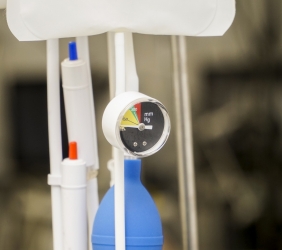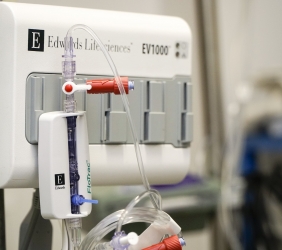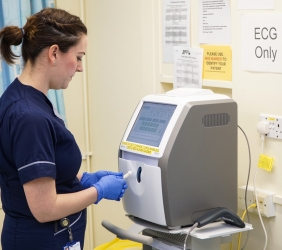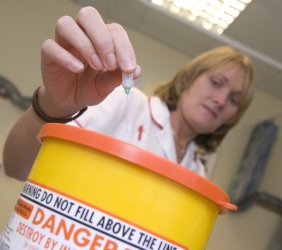Training
Arterial Lines
An arterial Line is a thin catheter that is inserted into an artery and connected to a transducer set. Arterial lines enable continuous blood pressure monitoring and access to arterial blood for point of care blood gas analysis and laboratory testing.
The three main sites for arterial cannulation are radial, brachial and femoral. Radial is often the preferred artery due to easy of access and being the most distal.
Arterial lines must be secured with a transparent dressing. They are occasionally sutured into place so this must be considered during care of the line and before removal.
Arterial line patency is maintained with a 0.9% sodium chloride flush, hung under a pressure of 300 millimetres of mercury. 0.9% sodium chloride is the only fluid that should be run through an arterial line giving set at York Teaching Hospital NHS Trust.
Arterial lines are normally used in specialist areas such as critical care and theatres because of the potential risks associate with their use. Since 2015, York Teaching Hospital has extended the use of arterial lines to the nurse enhanced unit on the surgical ward. Special safety measures have been put in place for the extension of their use in this clinical environment and all nursing staff in this area have received additional training.
Between 2005 and 2008 , the national patient safety agency had reports of two deaths and 82 other incidences where the wrong infusion fluid was attached to an arterial lines. A further 76 incidents including one case of serious harm, were related to faulty sampling technique. This training video has been created to help improve the dissemination of education around arterial lines. However, you should be signed off as competent and always follow Trust policy when using an arterial line. It is also important that you receive training from your local point of care trainer in the use of the arterial blood gas sampling machine.
There are a number of potential risks associated to the care and manipulation of arterial lines. These include;
- Air embolism: this can be caused by accidental injection of air into the line and is reduced by using non-injectable bungs, ensuring the line is adequately primed and expelling air from syringes prior to connection.
- Thrombosis: to prevent a thrombosis withdrawn blood should not be returned to the patient, the transducer set should be kept under a pressure of 300 millimetres of mercury to ensure line patiency and the entry site should be checked regularly.
- Accidental injection of medications or wrong flush fluid: only the snap back flush should be used for flushing the transducer set and arterial line. The flush bag must be a prescribed back of 0.9% sodium chloride and checked on each nurse change over. Here at York Teaching Hospital only one way, non-injectable bungs must be used on arterial line sets.
- Infection: use appropriate asceptic non-touch technique to reduce the risk of infection. The line should also be changed every 72 hours and the insertion site should be regularly monitored for signs of infection.
- Haemorrhage: if the patient is awake ensure they are made aware of the line and that accidental removal may cause excessive bleeding, check connections are tight, taps are left in the correct way and the dressing is secure. Alarms should be set on the monitoring equipment so that they will sound if the arterial trace is lost due to accidental removal. Where possible, ensure the line is visible to carers and a sign is placed on the patient board to ensure all staff are aware the line is in situ.
- Arterial injury: trauma to the artery can occur during insertion or if a line is in for a prolonged period of time. Correct insertion procedure can reduce this risk and regular observation and assessing of limb perfusion and sensation can help ensure early identification and treatment.





